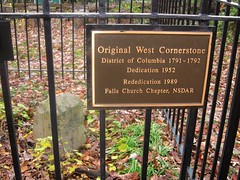
”Western’ Washington, D.C.(1)’
courtesy of ‘cizauskas’
I couldn’t quite decide what today’s greeting should be. The retrocession of the area of the federal district south of the Potomac River is a bit of a mixed bag, like most of American history. Ostensibly, it was done to pump capital into the neglected port of Alexandria, but it was also done to preserve the slave port at Alexandria, in an effort to preserve the union. As no federal buildings could be constructed west of the Potomac, none of the existing government structures were in the area, and it made for an easy give back to Virginia.
The process of retrocession took six years to accomplish, running from 1840 to 1846, as a complicated legislative dance had to occur. Alexandrians pushed hard for the process, petitioning Congress and the Virginia Assembly. In February of 1846, the Virginia Assembly voted to accept the retroceded county of Alexandria, provided that the Federal government were to permit such an action, and then five months later on July 9, 1846, Congress voted to retrocede the land south of the Potomac to Virginia. This added two pro-slavery seats to the Virginia Assembly, putting the hurt on the nascent abolitionist movement in the Virginia legislatural body, but also restored congressional representation to a group of citizens who had gone 45 years without it.
The process of retrocession has been floated as a solution to the District’s voting rights issues, wherein the non-federal portion of the city would be retroceded to Maryland, with those living therein becoming residents of Maryland. The land that the retrocedeable parts of the District would likely add fifteen seats to the Maryland House of Delegates, and three or four to the Maryland Senate, representing an increase of almost 10% to the size of those bodies. It would, however, drastically change the landscape, politically, within the District, with regard to federal funding, I’m certain.
Was the retrocession of Arlington a good idea? I’m not sold. It didn’t prevent the Civil War, just delayed it, and now that area is a deeply profitable part of the Virginia taxbase, which could do much to alleviate some of the grander budget issues that the District is now facing. Add in another 210,000 residents, and the District becomes nearly a million-person bloc that could petition Congress for clear and distinct representation, or petition for statehood outright. It’s a tough call, but something to think about.



It was a fantastic idea. It just depends on which side of the river you view the issue from.
I don’t want to rejoin the District. Arlington is safe and well-run. A better idea to be is to get out from under Richmond’s thumb and secede from Virginia with the rest of NoVA.
Incorporation as an independent city is more likely than secession.
But that’s like saying I would be more likely to hit the Moon with a spitball than Mars.
It was a serious upgrade for Arlington! And continues to be as no matter how badly Richmond mismanages thing? It still beats the heck of being under the District Government.
How did the retrocession of Arlington help delay the Civil War? Cizauskas can you please expand that thought.
“…and now that area is a deeply profitable part of the Virginia taxbase, which could do much to alleviate some of the grander budget issues that the District is now facing.”
Fallacious argument. If part of VA had stayed in the District from that time until now, they’d be in the same mess as the District is in currently. For all we know, Arlington might well have been just like SEDC if retrocession hadn’t happened…and the only people to profit from that situation would be politicians.